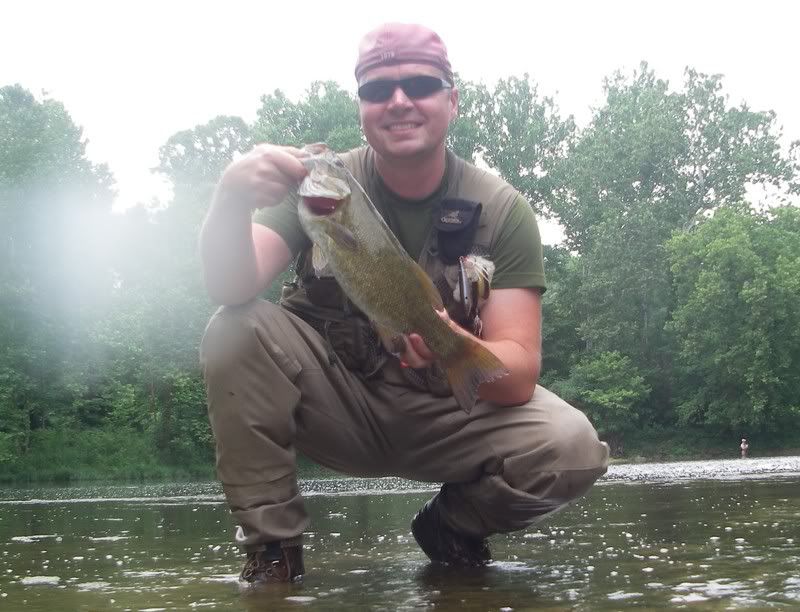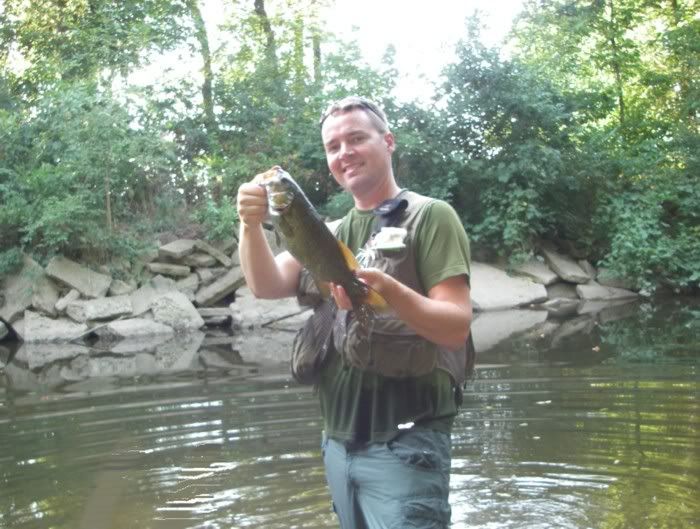A large black green torpedo shape darts out from a rocky underwater cleft, slamming on the breaks with her pectorals and for a second contemplating whether to destroy the spinning, clacking, buzzbait. Just as quickly, the bass returns to her cave under the barely trickling waterfall. Given this situation, an on foot angler might beat the spot to a froth with the same bait, forever turning the nice smallmouth bass off.
Pro tournament anglers carry multiple rigged rods with different presentations. They switch up from cast to cast when they observe a change in on the water circumstances. Retying can take too long when money and glory are at stake. The information a bass gives you must be acted upon immediately. Retying the best lure at every such opportunity all day will cost you precious moments that could have been used making more casts and covering water. Some such as myself are just plain knot lazy! A common solution is to load up like a chimney sweep and carry 2-3 rods in various rod holders or belts on the stream wader's person. That works well for the agile. For those who have trouble standing let alone navigating up and down banks, over beaver traps, and through the woods there is an alternative!

The common snap! Often confused with a snap swivel. Take away the swivel part and you've got a whirling dervish of lure changing power, the snap. A quick online search couldn't capture for me the inventor of this invaluable little piece of bent heavy gauge wire. Surely, it must rank up there with the with great inventions like handles on coffee mugs? A fishing snap allows for quick change of fishing lures once tied to your line. In the last couple years of tying this style snap to my lines, I cannot think of one example where a fish came off due to the snap failing in some way. When you lose lures occasionally, you do also lose a snap. Ordering them en mass from online tackle making warehouse like barlowstackle.com gets you lots of snaps ultra cheap. Meet the Duo Lock snap I prefer:

I keep my vest loaded with ready to throw lures. Typically, casting and change lure in less than a few seconds. Crankbait, Sammy, popper, prop bait, chatterbait, jerkbait, tube, or buzzbait depending on season are all at the ready on my chest or in a pouch easily reached. Minimal opening boxes or undoing zippers. A couple of rigged extra wide gap 4/0 4" tube jigs in a couple different weights depending on the situation at hand. These are stored at my waist pouches ready to be unvelcroed at a moments notice should the next cast need them. In the case of my opening scenario, the buzzbait revealed a fish's location. I quickly snapped it off, hooked it onto my fly hair, and threw the tube onto the snap. Pitched it 6' from the bass's location. The smallie didn't want the buzzbait, but he did want that tube helpless on the bottom! 18.5"er emerged from under his cliff to snarf it up! I didn't allow time for a mood change.

A good pair of polarized sunglasses are a must, as you are looking for sight clues as for what to throw. Structure and cover of course are clues, but swimming lunkers and panicky baitfish are too! Your eyes and ears are your best weapon in this kind of sight fishing.
Spending time on the rivers and creeks switching lures will begin to condition you. I began to notice certain baits performing well in certain situations, but not in others. Having a good idea what works best in various scenarios based on catching bass, you begin to know what will likely work best when you see types cover and structure. Don't try to make due with a suboptimal bait for each situation. Throwing bait might spook bass the least, to a mid column bait like a soft jerkbait or chatterbait, to a bottom bouncing plastic, finally to a clacking buzzbait. Depending on what gets hot be prepared to make it #1 on the list. If the buzzbait is on fire, I might use it exclusively pausing only to probe deep spots with a tube or let a fluke gets swept in. Throwing a different lure on 4 casts is not uncommon. Making a lot of casts and finding the key for the day. I am prepared to try each lure in turn. I can ride a hot lure, but going back to the best lure for each situation often pays off big despite an apparent hot lure. An example, would a hot prop bait bite and and undercut, rooty bank. The prop may move too fast for fish to react, while a slow popper may be just the ticket to bring them out of their safe home! If the popper didn't work, I'd want to probe the undercut with a texposed tube.

To speed up all changes the lures I go with are pinned to my chest, trebles fouled in the wool of my fishing vest's fly holder. Find the feeding pattern by cycling through your revolver of confidence lures. Too often an angler will throw one bait with decent success. Being happy with this is fine, but I believe the multi pronged approach will get a wider variety of moody fish to strike. This technique can be educational and rewarding when one bait works above and beyond another.
Another advantage of the snap system is using the same rod setup on every cast will reduce mistakes, there is no adjustment period as you switch rods. You simply have to compensate for the different weight of the lures you employ. Searching for the right feel to work your lures, feel lighter bites, cast more accurately.
Get out and practice on a stream somewhere. Try to remember how and why you caught each fish. When you start learning the strengths of certain baits based on your experience and your target, don't hesitate, use that snap! Have in mind your first 3 or 4 presentations for every piece of cover or eddy. This will allow you to run and gun with excellent efficiency, yet still sample all water columns and presentations. Be sure to get the bass back in the water quickly and keep them wet!

FAQ
Will the snap come open? Probably not unless you want it to or forget to close it.
Will I lose lures because of the snap? Check to make sure the hook eye is fully crimped down and you are OK.
Do the fish see the snap? Maybe, but bass aren't smart enough to not eat, consider visible hooks and weed guards.
What size snaps do you use? Size 1 or 2.
Can I use a swivel? This would not be good for the action of many lures, but may work great for some like spinners. Just the snaps, please.
What knot do you use to tie to the snap? Palomar knot tied with 15/4 or 20/6 Power Pro braid.
Pro tournament anglers carry multiple rigged rods with different presentations. They switch up from cast to cast when they observe a change in on the water circumstances. Retying can take too long when money and glory are at stake. The information a bass gives you must be acted upon immediately. Retying the best lure at every such opportunity all day will cost you precious moments that could have been used making more casts and covering water. Some such as myself are just plain knot lazy! A common solution is to load up like a chimney sweep and carry 2-3 rods in various rod holders or belts on the stream wader's person. That works well for the agile. For those who have trouble standing let alone navigating up and down banks, over beaver traps, and through the woods there is an alternative!

The common snap! Often confused with a snap swivel. Take away the swivel part and you've got a whirling dervish of lure changing power, the snap. A quick online search couldn't capture for me the inventor of this invaluable little piece of bent heavy gauge wire. Surely, it must rank up there with the with great inventions like handles on coffee mugs? A fishing snap allows for quick change of fishing lures once tied to your line. In the last couple years of tying this style snap to my lines, I cannot think of one example where a fish came off due to the snap failing in some way. When you lose lures occasionally, you do also lose a snap. Ordering them en mass from online tackle making warehouse like barlowstackle.com gets you lots of snaps ultra cheap. Meet the Duo Lock snap I prefer:

I keep my vest loaded with ready to throw lures. Typically, casting and change lure in less than a few seconds. Crankbait, Sammy, popper, prop bait, chatterbait, jerkbait, tube, or buzzbait depending on season are all at the ready on my chest or in a pouch easily reached. Minimal opening boxes or undoing zippers. A couple of rigged extra wide gap 4/0 4" tube jigs in a couple different weights depending on the situation at hand. These are stored at my waist pouches ready to be unvelcroed at a moments notice should the next cast need them. In the case of my opening scenario, the buzzbait revealed a fish's location. I quickly snapped it off, hooked it onto my fly hair, and threw the tube onto the snap. Pitched it 6' from the bass's location. The smallie didn't want the buzzbait, but he did want that tube helpless on the bottom! 18.5"er emerged from under his cliff to snarf it up! I didn't allow time for a mood change.

A good pair of polarized sunglasses are a must, as you are looking for sight clues as for what to throw. Structure and cover of course are clues, but swimming lunkers and panicky baitfish are too! Your eyes and ears are your best weapon in this kind of sight fishing.
Spending time on the rivers and creeks switching lures will begin to condition you. I began to notice certain baits performing well in certain situations, but not in others. Having a good idea what works best in various scenarios based on catching bass, you begin to know what will likely work best when you see types cover and structure. Don't try to make due with a suboptimal bait for each situation. Throwing bait might spook bass the least, to a mid column bait like a soft jerkbait or chatterbait, to a bottom bouncing plastic, finally to a clacking buzzbait. Depending on what gets hot be prepared to make it #1 on the list. If the buzzbait is on fire, I might use it exclusively pausing only to probe deep spots with a tube or let a fluke gets swept in. Throwing a different lure on 4 casts is not uncommon. Making a lot of casts and finding the key for the day. I am prepared to try each lure in turn. I can ride a hot lure, but going back to the best lure for each situation often pays off big despite an apparent hot lure. An example, would a hot prop bait bite and and undercut, rooty bank. The prop may move too fast for fish to react, while a slow popper may be just the ticket to bring them out of their safe home! If the popper didn't work, I'd want to probe the undercut with a texposed tube.

To speed up all changes the lures I go with are pinned to my chest, trebles fouled in the wool of my fishing vest's fly holder. Find the feeding pattern by cycling through your revolver of confidence lures. Too often an angler will throw one bait with decent success. Being happy with this is fine, but I believe the multi pronged approach will get a wider variety of moody fish to strike. This technique can be educational and rewarding when one bait works above and beyond another.
Another advantage of the snap system is using the same rod setup on every cast will reduce mistakes, there is no adjustment period as you switch rods. You simply have to compensate for the different weight of the lures you employ. Searching for the right feel to work your lures, feel lighter bites, cast more accurately.
Get out and practice on a stream somewhere. Try to remember how and why you caught each fish. When you start learning the strengths of certain baits based on your experience and your target, don't hesitate, use that snap! Have in mind your first 3 or 4 presentations for every piece of cover or eddy. This will allow you to run and gun with excellent efficiency, yet still sample all water columns and presentations. Be sure to get the bass back in the water quickly and keep them wet!

FAQ
Will the snap come open? Probably not unless you want it to or forget to close it.
Will I lose lures because of the snap? Check to make sure the hook eye is fully crimped down and you are OK.
Do the fish see the snap? Maybe, but bass aren't smart enough to not eat, consider visible hooks and weed guards.
What size snaps do you use? Size 1 or 2.
Can I use a swivel? This would not be good for the action of many lures, but may work great for some like spinners. Just the snaps, please.
What knot do you use to tie to the snap? Palomar knot tied with 15/4 or 20/6 Power Pro braid.
Thanks for this great tip! Also, very well written; entertaining and informative.
ReplyDeleteGlad you like!
ReplyDeleteJust 17 years later and I still use snaps on every line tie for quick changing. I have had a couple fish lost in 20 years of fishing from the snap opening. 2/25,000+ is a great number. More often, I lost a lure because I didn't check it was closed.
ReplyDeleteOn wades I do now bring 2 rods, one with fluro for bottom andslow presentations and one with 15 braid for topwater and fast moving baits like jackhammers.